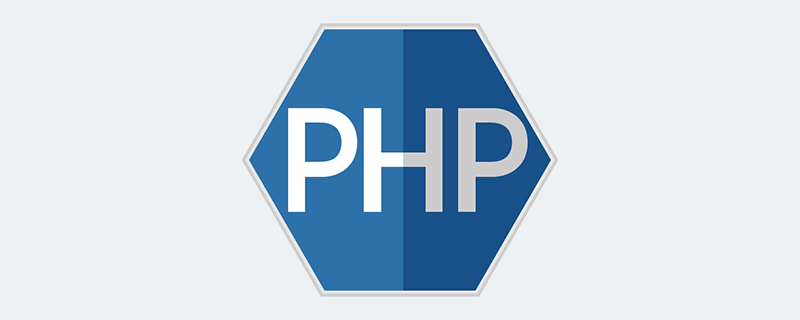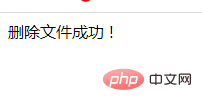 Backend Development
Backend Development
 PHP Problem
PHP Problem
 How to copy, delete, rename files and create a temporary file in PHP?
How to copy, delete, rename files and create a temporary file in PHP?
How to copy, delete, rename files and create a temporary file in PHP?
In the previous article, I brought you "Teach you how to write a file in PHP in three minutes", which introduced in detail how we write a file in PHP. This article Continue to bring you some knowledge about the PHP file system, such as creating a temporary file, how to copy and delete a file. Hope it helps everyone!

How to create a temporary file?
In our last article, the files we wrote and created are permanent. In our daily development and use, it is also necessary to create a temporary file, and very useful.
Create a temporary file that can be deleted after we are finished using it. We do not need to maintain the deletion status of this file.
Then we need to use the resource tmpfile ( ) function, the example is as follows:
<?php //创建了一个临时文件 $a = tmpfile(); //向里面写入了数据 $b = fwrite($a, '好好学习天天学习'); //关闭临时文件,文件即被删除 fclose($a); echo '向临时文件中写入了'.$b . '个字节'; ?>
Output result:

As can be seen from the above example, a temporary file is created through the resource tmpfile () function and the resource type is returned. The file is deleted when it is closed.
How to rename a file?
When we deal with files daily, we not only need to create them, but sometimes we also need to rename the files that have been created. Then let’s take a look at what should be done. Go and rename the file.
At this time we will use rename. The syntax format is as follows:
bool rename($旧名,$新名);
The example is as follows:
First, I created a file named test.txt

Next, enter:
<?php //旧文件名 $a = 'test.txt'; //新文件名 $b = 'newtest.txt'; //复制文件 rename($a, $b); ?>
After outputting the results, the file originally named test.txt is now:

From the above example, Files can be renamed through rename.
How to copy files?
# Copying files is also a common operation in our daily life, so how should we implement it?
bool copy(源文件,目标文件)
The example is as follows:
Same as the above example, I first created a test.txt file
<?php //旧文件名 $a = 'test.txt'; //新文件名 $b = 'test_new.txt'; //修改名字。 copy($a, $b); ?>
By copying, the output result is:

From the above results, we know that files can be copied through copy().
How to delete files?
#Deleting a file means deleting a file in the specified path, but this deletion is direct deletion. If you are using a Windows computer, you cannot see this file in the Recycle Bin. You will find that the file simply disappears.
bool unlink(指定路径的文件)
The example is as follows:
<?php
$a = 'test.txt';
if (unlink($a)) {
echo "删除文件成功 $filename!\n";
} else {
echo "删除 $a 失败!\n";
}
?>Output result:


As can be seen from the above example, files can be deleted through unlink.
Recommended learning: "PHP Video Tutorial"
The above is the detailed content of How to copy, delete, rename files and create a temporary file in PHP?. For more information, please follow other related articles on the PHP Chinese website!

Hot AI Tools

Undresser.AI Undress
AI-powered app for creating realistic nude photos

AI Clothes Remover
Online AI tool for removing clothes from photos.

Undress AI Tool
Undress images for free

Clothoff.io
AI clothes remover

AI Hentai Generator
Generate AI Hentai for free.

Hot Article

Hot Tools

Notepad++7.3.1
Easy-to-use and free code editor

SublimeText3 Chinese version
Chinese version, very easy to use

Zend Studio 13.0.1
Powerful PHP integrated development environment

Dreamweaver CS6
Visual web development tools

SublimeText3 Mac version
God-level code editing software (SublimeText3)

Hot Topics
 1377
1377
 52
52
 PHP 8.4 Installation and Upgrade guide for Ubuntu and Debian
Dec 24, 2024 pm 04:42 PM
PHP 8.4 Installation and Upgrade guide for Ubuntu and Debian
Dec 24, 2024 pm 04:42 PM
PHP 8.4 brings several new features, security improvements, and performance improvements with healthy amounts of feature deprecations and removals. This guide explains how to install PHP 8.4 or upgrade to PHP 8.4 on Ubuntu, Debian, or their derivati
 Discuss CakePHP
Sep 10, 2024 pm 05:28 PM
Discuss CakePHP
Sep 10, 2024 pm 05:28 PM
CakePHP is an open-source framework for PHP. It is intended to make developing, deploying and maintaining applications much easier. CakePHP is based on a MVC-like architecture that is both powerful and easy to grasp. Models, Views, and Controllers gu
 How To Set Up Visual Studio Code (VS Code) for PHP Development
Dec 20, 2024 am 11:31 AM
How To Set Up Visual Studio Code (VS Code) for PHP Development
Dec 20, 2024 am 11:31 AM
Visual Studio Code, also known as VS Code, is a free source code editor — or integrated development environment (IDE) — available for all major operating systems. With a large collection of extensions for many programming languages, VS Code can be c
 How do you parse and process HTML/XML in PHP?
Feb 07, 2025 am 11:57 AM
How do you parse and process HTML/XML in PHP?
Feb 07, 2025 am 11:57 AM
This tutorial demonstrates how to efficiently process XML documents using PHP. XML (eXtensible Markup Language) is a versatile text-based markup language designed for both human readability and machine parsing. It's commonly used for data storage an
 CakePHP Quick Guide
Sep 10, 2024 pm 05:27 PM
CakePHP Quick Guide
Sep 10, 2024 pm 05:27 PM
CakePHP is an open source MVC framework. It makes developing, deploying and maintaining applications much easier. CakePHP has a number of libraries to reduce the overload of most common tasks.
 PHP Program to Count Vowels in a String
Feb 07, 2025 pm 12:12 PM
PHP Program to Count Vowels in a String
Feb 07, 2025 pm 12:12 PM
A string is a sequence of characters, including letters, numbers, and symbols. This tutorial will learn how to calculate the number of vowels in a given string in PHP using different methods. The vowels in English are a, e, i, o, u, and they can be uppercase or lowercase. What is a vowel? Vowels are alphabetic characters that represent a specific pronunciation. There are five vowels in English, including uppercase and lowercase: a, e, i, o, u Example 1 Input: String = "Tutorialspoint" Output: 6 explain The vowels in the string "Tutorialspoint" are u, o, i, a, o, i. There are 6 yuan in total
 Explain JSON Web Tokens (JWT) and their use case in PHP APIs.
Apr 05, 2025 am 12:04 AM
Explain JSON Web Tokens (JWT) and their use case in PHP APIs.
Apr 05, 2025 am 12:04 AM
JWT is an open standard based on JSON, used to securely transmit information between parties, mainly for identity authentication and information exchange. 1. JWT consists of three parts: Header, Payload and Signature. 2. The working principle of JWT includes three steps: generating JWT, verifying JWT and parsing Payload. 3. When using JWT for authentication in PHP, JWT can be generated and verified, and user role and permission information can be included in advanced usage. 4. Common errors include signature verification failure, token expiration, and payload oversized. Debugging skills include using debugging tools and logging. 5. Performance optimization and best practices include using appropriate signature algorithms, setting validity periods reasonably,
 7 PHP Functions I Regret I Didn't Know Before
Nov 13, 2024 am 09:42 AM
7 PHP Functions I Regret I Didn't Know Before
Nov 13, 2024 am 09:42 AM
If you are an experienced PHP developer, you might have the feeling that you’ve been there and done that already.You have developed a significant number of applications, debugged millions of lines of code, and tweaked a bunch of scripts to achieve op



